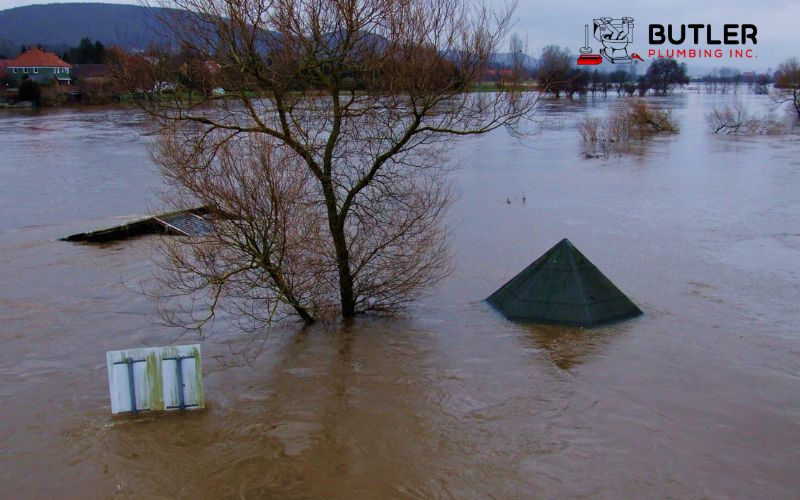Oklahoma River: Getting to Know the River and Its Role in the Plumbing System
The Oklahoma River is a 7-mile stretch of the North Canadian River in Oklahoma City, bordered by landscaped areas, trails, and recreational facilities. The official boundaries are Eastern Avenue on the east and Meridian Avenue on the west, spanning 7 miles through Oklahoma City and regulated by dams and locks along its stretch.
The Oklahoma River is man-made, and its water source is the North Canadian River.
Recreational activities that can be enjoyed in the Oklahoma River include rowing, kayaking, boat racing, fishing, and various water sports, such as whitewater rafting and kayaking at the Boathouse District.
Even though the Oklahoma River does not provide drinking water to Oklahoma City, it serves as a discharge place of water reservoirs like lakes Overholser and Hefner.
The History of the Oklahoma River
The Oklahoma River was part of the original MAPS (Metropolitan Area Projects Plan) projects and was completed in 2004 for $54 million. Before MAPS, the area had been a dry riverbed with redirected water to avoid flooding downtown Oklahoma City.
The river was originally a vital water source for early settlers and a venue for entertainment offerings like Delmar Gardens at the turn of the 20th century. It was, however, abandoned due to flooding, but it was revived in the 1990s with the approval of a one-cent sales tax in 1993 and again in 2009.
Where is the Oklahoma River located?

The Oklahoma River is located just south of I-40 between Portland Ave. & I-35 in Oklahoma City, adjacent to downtown and within walking distance of the Bricktown entertainment district.
The boundaries defining the Oklahoma River are:
- Eastern Boundary: Eastern Avenue on the east side of the river
- Western Boundary: Meridian Avenue on the west side of the river.
The river flows for 7 miles between these two avenues through Oklahoma City. Dams at Eastern, Western, and May Avenues regulate the water levels and create a series of river lakes. The locks at Western and May Avenues allow boats to navigate the entire 7-mile length between Eastern and Meridian Avenues
How long is the Oklahoma River?
The Oklahoma River spans 7 miles and 11 kilometers.
What major city does the North Canadian River flow through?
North Canadian River flows through Oklahoma City, which is the capital and largest city in the state of Oklahoma.
What is the elevation change of the Oklahoma River from source to mouth?
The elevation change is 1,005 feet of drop from source to mouth.
The source of the Oklahoma River is in the Wichita Mountains in southwestern Oklahoma, at an elevation of around 1500 feet.
The mouth of the Oklahoma River is where it joins the Arkansas River near Muskogee, Oklahoma, at an elevation of around 490 feet.
What type of river is the Oklahoma River?
Oklahoma River is an engineered river system that was created in 2004 by damming and transforming a dry section of the North Canadian River running through Oklahoma City
What are the common uses of the Oklahoma River?
Visitors can engage in rowing, kayaking, boat racing, and fishing, making it an ideal destination for water sports enthusiasts.
Additionally, the Oklahoma River is a premiere center for river sports, attracting visitors from around the world to partake in its offerings.
The river’s scenic beauty, combined with its cultural and historical significance, makes it a popular destination for outdoor enthusiasts and families seeking a unique and engaging experience in Oklahoma City.
What type of wildlife is supported by the Oklahoma River?
The Oklahoma River supports a diverse range of wildlife, particularly in terms of fish and freshwater mussels unique to the eastern regions of the country.
Additionally, the surrounding natural habitats and waterways provide a home for various species, including migrating shorebirds, songbirds, salamanders, bats, beavers, swamp rabbits, gray squirrels, wild turkey, bald eagles, ducks, mallards, herons, and other wildlife.
The Oklahoma River supports a variety of freshwater wildlife, including fish species such as catfish, largemouth bass, carp, and buffalo fish. Other wildlife found along the river and its shores include ducks, geese, songbirds, squirrels, rabbits, turtles, snakes, beavers, and alligators. The river and associated wetlands provide important habitat for migrating birds. Overall, the diversity of aquatic and riparian habitats along the Oklahoma River allow it to support an array of wildlife species.
Recreation in the Oklahoma River
The Oklahoma River is a popular destination for outdoor enthusiasts and families seeking a unique and engaging experience in Oklahoma City. The river offers a variety of recreational activities, such as rowing, kayaking, boat racing, and fishing, making it an ideal destination for water sports enthusiasts.
Visitors can also engage in canoeing, swimming, picnicking, and hiking, with thirteen miles of paved river trails available for runners, rollerbladers, skateboarders, bicyclists, and those with mobility aids.
Can you sail or pilot boats in the Oklahoma River?
Sailing is a recreational activity that is done in the Oklahoma River following these restrictions:
- The Oklahoma River is considered a “no wake” zone, so motorized boats are not allowed to operate at speeds that would create a wake
- All boats require a permit from the City of Oklahoma City and state registration (except for kayaks, canoes, and paddleboats which only need the city permit.
- Waterskiing, parasailing, swimming, sailboarding, and windsurfing are prohibited.
- Boats must stay at least 100 feet away from dams and locks. There are locks at the Western Ave and May Ave dams to allow boats to traverse the length of the river on special occasions.
- The river has public boat ramps located at SW 15th and Portland, Regatta Park near Reno Ave, and the Exchange Ave Bridge.
- Allowed watercraft include kayaks, canoes, paddle boats, rowing shells, motor boats, fishing boats, and sailboats
Can you kayak in the Oklahoma River?
Kayaking is the sport of paddling a kayak. Friends and family can kayak in the Oklahoma River but following these rules is important for your safety:
- The 7-mile engineered river system provides ideal conditions for kayaking, with calm waters and a “no wake” rule for motorized boats.
- Public access points like the Boathouse District offer hourly kayak rentals and access to launch your own kayak.
- Kayaking is allowed year-round, but summertime is peak season when the water is warmer and there are more rental options.
- The river has a city permit requirement but no state registration is needed for kayaks and canoes
- Beginner-friendly conditions make it a popular spot for casual paddling. The river also hosts kayak sports events and teams.
- Nearby lakes Overholser and Hefner also offer kayak access and rentals.
Can you canoe in the Oklahoma River?
Canoeing is a popular recreational activity in the Oklahoma River. The Oklahoma River is a 7-mile stretch of the North Canadian River that was transformed into a series of river lakes in Oklahoma City, making it ideal for recreational activities like canoeing and kayaking. Motorized boats are allowed but have strict no-wake rules.
Can you row in the Oklahoma River?

Rowing is another favorite recreational activity in the Oklahoma River. The Oklahoma River has become a popular spot for rowing, with the Boathouse District along with its banks offering facilities and programs for recreational and competitive rowing. Public access is available through boat ramps. The river is ideal for rowing shells and sculls given its flatwater setup and length. Rowing organizations like Riversport OKC offer coaching, training programs, and events for rowers of all levels. So the Oklahoma River welcomes and provides good conditions for recreational and competitive rowing. Some basic rules and permits apply for using the river. But it is a premier destination for rowing in Oklahoma.
Can you run the riverwalk of the Oklahoma River?
There are 17.5 miles of paved trails that you can run along both banks of the Oklahoma River and the adjoining North Canadian River. These trails, known as the Oklahoma River Trails, provide a smooth pathway for running and other activities. The trails offer scenic riverfront views and connect a number of parks and attractions. Access points are available from parking areas along the route, like the Boathouse District. So the extensive network of trails along the Oklahoma River accommodates and welcomes runners of all levels to enjoy running by the water.
Can you go fishing in the Oklahoma River?
Fishing is permitted in the Oklahoma River with the proper licenses and permits. The river contains several species including catfish, hybrid striped bass, largemouth bass, and sunfish. Good access points for shore fishing include the fishing piers at the Stinchcomb Wildlife Refuge and the boat ramps at SW 15th and Portland and in Regatta Park. Anglers should stay at least 100 feet away from dams for safety. While swimming and wading are prohibited, fishing from non-motorized boats, kayaks, and canoes is also allowed on certain sections of the river with the required permits. With abundant fish species present, the Oklahoma River provides quality fishing opportunities within Oklahoma City when following the appropriate regulations.
Is the Oklahoma River protected from pollution with a plumbing system?
The Oklahoma River does not have a dedicated plumbing system to protect it from pollution. However, there are various regulations and initiatives aimed at reducing pollution and protecting water quality in the river:
The Oklahoma River was created through the damming and channelization of the North Canadian River. As an urban river flowing through Oklahoma City, it receives stormwater runoff and treated wastewater discharges from the municipal sewer system.
To protect water quality, the Oklahoma Department of Environmental Quality (ODEQ) issues National Pollutant Discharge Elimination System (NPDES) permits for wastewater and stormwater discharges into the river. These permits limit the amounts of pollutants like nutrients, bacteria, and sediments.
The City of Oklahoma City also has initiatives to reduce trash and pollution entering the river. For example, the Riversport River Protectors program organizes river cleanups and public education to prevent litter.
While the river does not have a dedicated plumbing system, regulations on wastewater discharges and public involvement in reducing pollution sources help protect water quality for recreation and wildlife habitat in the Oklahoma River. Ongoing monitoring and improvement of stormwater and wastewater systems is needed to further reduce contaminants entering the urban waterway.
Does the Oklahoma River provide drinking water to Oklahoma City?
No, Oklahoma City’s drinking water primarily comes from reservoir lakes that are supplied by the North Canadian River, such as Lake Overholser and Lake Hefner. The city also brings in water from lakes and rivers located further away, like Lake Atoka which is 100 miles away. The Oklahoma River itself is not used to supply drinking water.
How does the Oklahoma River contribute to flooding control?

The river itself provides a controlled channel for water to flow through the Oklahoma City area rather than overflowing the banks of the North Canadian River which previously caused damaging floods.




